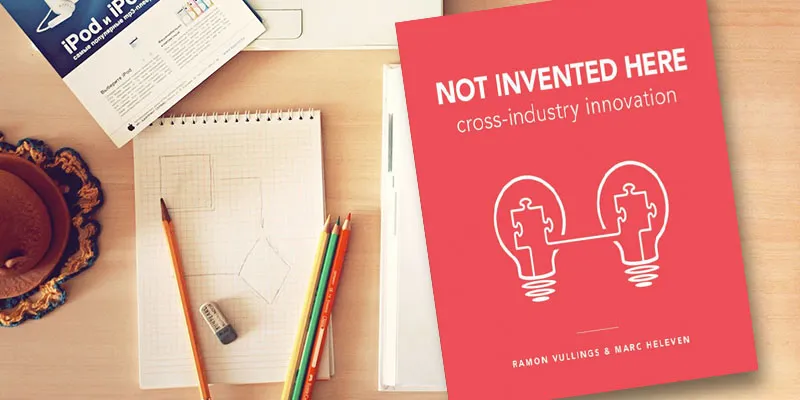Adapt-and-paste, don’t copy-and-paste: four tips on cross-industry innovation
There are so many startups today who want to position themselves as the equivalent of companies like Uber or AirBnB in completely different sectors. Cross-industry innovation is on the rise as never before, thanks to the global growth of entrepreneurship, deeper understanding of innovation processes, and the ready availability of online resources for innovators.

What can a restaurant learn from an airport, a car manufacturer from the games industry, a hospital from a hotel or theme park, or a chemical company from a festival organiser? A wide range of tips and case studies for such cross-industry innovation are offered in the new book ‘Not Invented Here,’ by Ramon Vullings and Marc Heleven of innovation consultancy 21 Lobsterstreet.
The compact 224-page book is designed almost like a cookbook, with plenty of photographs, illustrations and checklists on how innovators can frame contexts, unpack insights from other industries and transfer them to their own companies. See also my book reviews of ‘Peers Inc.’ (Robin Chase), ‘Four Lenses of Innovation’ (Rowan Gibson), ‘Innovators’ DNA’ (Clayton Christensen), and ‘Steal Like an Artist’ (Austin Kleon).
“Cross-industry innovation is the commitment we make to the process of asking questions, combining elements, finding patterns and testing concepts,” the authors begin.
Here are my four key sets of takeaways and tips from the book, on how to effectively see and use analogies from other industries. There is also an online companion for effective ‘conceptualise-combine-create’ techniques with interactive tools, maps and examples.
1. Learn from the cross-industry innovators
“You need to go through craziness to be able to jump out of the limiting box of best practices to enter the world of next practices,” the authors explain. A huge pool of case studies has been gathered on cross-industry innovation. The key is to go beyond ‘copy and paste’ to ‘adapt and paste,’ via enrichment, customisation, modification, blending and fusion.
BMW’s iDrive system is inspired by a video console. Nike Shox shoes draw on the springiness of shock absorbers from Formula One racing, and the Waffle shoe was inspired by the waffle iron of Founder Bill Bowerman’s wife. The Worx automatic screwdriver is shaped like a revolver where drill bits can be loaded like bullets.
Doug Dietz of GE Healthcare redesigned CT scan rooms like game parks to make them less scary for children. Sushi restaurants use airport-style conveyor belts to provide diners a wide range of fresh dishes.
KLM borrowed social media concepts for its ‘Meet and Seat’ facility to let passengers choose their flight companions. The NeoNurture affordable incubator in Indonesia is designed from car parts.
Nature itself offers innovation models for industry. Japan’s high-speed train engines are designed to look like a kingfisher beak. Velcro design is based on seeds of plants that cling to animal fur. Speedo Fastskin swimsuits mimic a shark’s skin.
Sectors that have fertilised other segments with concepts, practices and metaphors include airlines (foldable prams, hub, payloads, frequent flyer miles, parachute, safety check, double check), aerospace (capsules, satellites, aliens, launchpads, lift-off, touchdown), military (boot camp, commando teams, laser focus, drills), Formula One (pit stop, dashboard), and fashion (catwalk, connected clothing, fashion wearables, fast fashion, fashion statement).
However, there are a wide range of obstacles, mental blocks and attitudes which prevent people from learning from other industries, as identified by the authors. Our customers won’t accept it. We are not Apple. We have our own R&D department. We can’t change the rules. That won’t work here.
2. The art and power of questioning
Successful innovators constantly change things by asking questions like why, what if, and how as they frame their offerings and their companies. Innovative companies have a culture of inquiry, of asking deep and powerful questions. Setting an innovation challenge is a good way to get started and focused.
Looking “sideways” helps see how others have solve related problems or components of problems – which can include products, services and even internal processes. Company visits, international travel, science fiction, history, patent databases, crowd platforms, curated sites, social media and hackathons are some good sources of outside ideas.
“Beautiful questions” are thought-provoking, test assumptions, focus on the customer and channels, stimulate reflective and creative conversation, and evoke more questions. German companies such as Daimler, Bayer, Siemens and SAP even have a ‘department of fundamental questions.’
The authors offer a useful visioning exercise: WWXD (‘what would X do’ in your company, eg. Steve Jobs, Google, AliBaba, NetFlix, Zara). Lego is a good company to study for its modular and compatible approach to products, processes, channels and brands. Apple Stores offer good lessons in design, multi-sensory experiences and sales staff diversity. IKEA stands out for its products which can be easily transported and assembled, management style by ‘walking around,’ and naming conventions.
3. Map cross-industry innovation patterns
Companies which strongly focus on customer interaction and business value will migrate across the full value chain: commodities, products, services, solutions, experience and engagement. Growth leaps come from techniques such as simplification, digital channels (eg. e-commerce, IoT), higher level positioning, and effective business models (eg sharing economy, green economy).
Based on cross-industry research, the authors offer a practical checklist of 21 innovation principles for companies to adopt and operationalise, eg. hybridisation, transparency, P2P, co-branding, frugality, storytelling, community building, DIY, crowdsourcing and bio-mimicry.
4. Transform your company
Once the applicable innovation patterns from other industries have been indentified, they can be used to transform a company in a number of ways: finding shortcuts, reducing complexity, changing rules, removing some elements, cutting prices, flipping to opposite positions, vaulting to previously impossible levels, and blending business models.
‘Shortcut’ principles are exemplified in price comparison sites, P2P lending and crowdfunding. Companies like Tesla are ‘challenging the rules’ of the car industry. ‘Removing some elements’ is shown by Cirque du Soleil (circus with no animals). Examples of ‘doing the opposite’ are reverse graffiti (selectively removing dirt from a surface, instead of adding new material).
In all, there are around 55 business model patterns that companies can experiment with, as identified by researchers at the University of St. Gallen (see PDF). They include add-on, crowdsourcing, fractional ownership, freemium, hidden revenue, ingredient branding, layer player, orchestrator, pay per use and trash-to-cash.
Overall, the book is a practical yet delightful exploration of cross-industry innovation, with lots of insights and humour blended in, eg. why can you easily test-drive a car – yet not test-sleep a house you want to buy; why can’t road tarmacs be designed as solar panels.
The authors also offer a number of creative word games to trigger out-of-the-box thinking, eg. synonyms for service or reduction; terms for combinations (dual, hybrid, smart, mixed); prefixes for experience (emotional, retro), dimensions (nano, pocket, flexible), and sustainability (eco, fair).
The authors also identify some disappearing objects (eg. fax machines, answering machines, pagers, subway tokens) and disappearing jobs (typist, meter reader) – as well as emerging jobs, eg. garbage designer, nostalgist, gamification designer, ideaDJ!
“It’s time to disrupt your industry or maybe even better – disrupt another industry,” the authors provocatively conclude.







![[Funding alert] Group health insurance startup Plum raises Rs 7 Cr in seed round led by Incubate Fund](https://images.yourstory.com/cs/2/b87effd06a6611e9ad333f8a4777438f/Imagein12-1594703768248.jpg)



